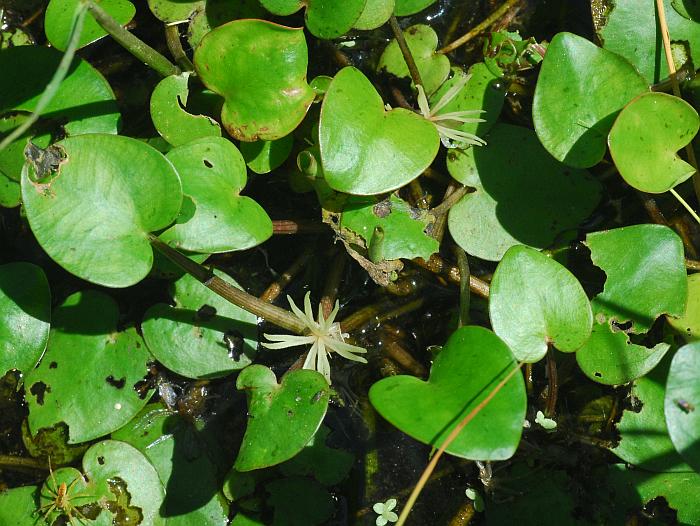Limnobium spongia (Bosc) Rich. ex Steud.
American Frogbit

Native
CC = 10
CW = -5
MOC = 6
SRank = S2
© SRTurner
Limnobium spongia (Bosc) Rich. ex Steud.American Frogbit | |
 |
Native CC = 10 CW = -5 MOC = 6 SRank = S2 |
© SRTurner |
|
Family - Hydrocharitaceae Habit - Perennial monoecious forb, emergent aquatic. Stems - Mostly unbranched stolons to 50 cm long, rooting at the nodes and with apparent rosettes of floating or emergent leaves that are actually highly condensed, branched stem systems. Leaves - Leaves of rosettes with petioles to 12 cm long, the leaf blades 1-8 cm long, ovate to nearly orbicular, the bases usually cordate, the tips rounded to broadly pointed, the margins entire or minutely toothed, the main veins 3-7, arching, the undersurface (especially of floating leaves) with a spongelike mass of enlarged cells.
Inflorescence - Spathes from the leaf axils, 15-50 mm long, the bracts free, with 3-25 flowers. Flowers with stalks 3-11 cm long, lacking nectaries.
Flowers - Staminate flowers with sepals 5-9 mm long, elliptic, the petals 5-13 mm long, linear to lanceolate or narrowly oblanceolate, white. Fertile stamens 8-14 (mostly 12), the filaments fused at the base, 1-5 linear staminodes also often present. Pistillate flowers with sepals 5-12 mm long, elliptic, the petals 5-14 mm long, linear to lanceolate or narrowly oblanceolate, white, usually also with 1-4(-7) reduced, linear staminodes. Styles 6-9, mostly deeply 2-lobed.
Fruits - Fruits 4-14 mm long, globose to ovoid, the tip with a short, stout beak. Flowering - June - September. Habitat - Emergent aquatic; sloughs, ditches, swampy forests, in slow-moving or stagnant water with muddy substrate. Origin - Native to the U.S. Lookalikes - Vegetatively, this plant appears similar to species of Heteranthera (mud plantain) and Eichhornia (water hyacinth), though the flowers are unique and quite distinct from those of the lookalikes. Other info. - This species is uncommon in Missouri, currently known from only six counties near the Bootheel. Its U.S. distribution includes areas of the Southeast, predominantly in coastal regions. The spongy tissue evident near the base of floating leaves evidently aids in buoyancy. The flowers are apparently mostly wind-pollinated but also are visited by small insects. Missouri material is assignable to ssp. spongia. Another subspecies, ssp. laevigatum (Bosc) Steud., occurs in the West Indies and from Mexico to Argentina. It has spatulate leaves, fewer stamens and styles, and petals absent or reduced and often 2-lobed. Photographs taken at Duck Creek Conservation Area, Stoddard County, MO, 7-31-2015 and 8-12-2015 (SRTurner). |